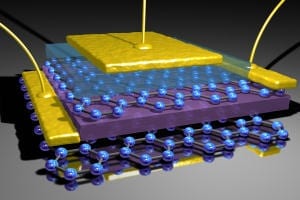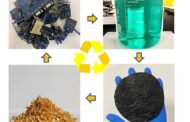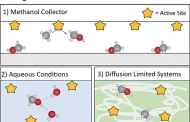A new transistor capable of revolutionising technologies for medical imaging and security screening has been developed by graphene researchers from the Universities of Manchester and Nottingham.
Writing in Nature Communications, the researchers report the first graphene-based transistor with bistable characteristics, which means that the device can spontaneously switch between two electronic states. Such devices are in great demand as emitters of electromagnetic waves in the high-frequency range between radar and infra-red, relevant for applications such as security systems and medical imaging.
Bistability is a common phenomenon – a seesaw-like system has two equivalent states and small perturbations can trigger spontaneous switching between them. The way in which charge-carrying electrons in graphene transistors move makes this switching incredibly fast – trillions of switches per second.
Wonder material graphene is the world’s thinnest, strongest and most conductive material, and has the potential to revolutionise a huge number of diverse applications; from smartphones and ultrafast broadband to drug delivery and computer chips. It was first isolated at The University of Manchester in 2004.
The device consists of two layers of graphene separated by an insulating layer of boron nitride just a few atomic layers thick. The electron clouds in each graphene layer can be tuned by applying a small voltage. This can induce the electrons into a state where they move spontaneously at high speed between the layers.
Because the insulating layer separating the two graphene sheets is ultra-thin, electrons are able to move through this barrier by ‘quantum tunnelling’. This process induces a rapid motion of electrical charge which can lead to the emission of high-frequency electromagnetic waves.
These new transistors exhibit the essential signature of a quantum seesaw, called negative differential conductance, whereby the same electrical current flows at two different applied voltages. The next step for researchers is to learn how to optimise the transistor as a detector and emitter.
One of the researchers, Professor Laurence Eaves, said: “In addition to its potential in medical imaging and security screening, the graphene devices could also be integrated on a chip with conventional, or other graphene-based, electronic components to provide new architectures and functionality.
“For more than 40 years, technology has led to ever-smaller transistors; a tour de force of engineering that has provided us with today’s state-of-the-art silicon chips which contain billions of transistors. Scientists are searching for an alternative to silicon-based technology, which is likely to hit the buffers in a few years’ time, and graphene may be an answer.”
The Latest Bing News on:
Revolutionary transistor technology
- Major Technology and Innovation Exhibitions in Germany in 2024 and 2025on April 26, 2024 at 12:30 pm
Technology and innovation exhibitions play an important role in today’s world. At no time in human history has technology changed at such an unrealistic rate. Trade shows continue to be platforms for ...
- 3 Semiconductor Stocks That Could Be Multibaggers in the Making: April Editionon April 25, 2024 at 3:00 am
Stock Market News, Stock Advice & Trading Tips Semiconductors remain a red hot field of technology. Market analyst Charlie ...
- TSMC debuts A16 technology at 2024 North America Technology Symposiumon April 25, 2024 at 1:24 am
North America Technology Symposium, TSMC demonstrated its latest semiconductor process, advanced packaging, and 3D IC technologies, which will drive the next wave of AI developments with silicon ...
- How sustainable solutions are empowering semiconductor technology?on April 23, 2024 at 1:31 am
Understanding that corrosion is highly responsible for breakdown of machines, additional maintenance, and costly repairs of the semiconductors, it can jeopardize the growth of the industry. In ...
- How the iPhone’s A18 Pro chip will supercharge Apple’s AI revolutionon April 21, 2024 at 10:30 am
Apple keeps using the A17 Pro for the iPhone 16 and 16 Plus; the A18 Pro is the only “new” iPhone chip this year. This is what Apple did in the iPhone 14 and iPhone 15 generations.
- Congressman says expansion of semiconductor industry in Texas is 'the biggest technology revolution since the Manhattan Project'on April 21, 2024 at 6:10 am
Congressman Michael McCaul also discussed why it’s important for the U.S. to lower its dependence on China and Taiwan.
- Apple iPhone 16 Pro Camera Upgrade Includes Latest Cutting-Edge Technologyon April 19, 2024 at 5:52 pm
The next iPhone will push the smartphone camera further than Apple’s previous endeavours with its new hardware and revolutionary software.
- Graphene’s Light-Speed Electrons Promise Revolution in Nanoscale Transistorson April 18, 2024 at 3:24 pm
Researchers have shown that double-layer graphene can function both as a superconductor and an insulator, a property that could revolutionize transistor technology. This dual functionality allows for ...
- 2 Best Semiconductor ETFs to Buy Now, as the Artificial Intelligence (AI) Revolution Powers Chip Demandon April 18, 2024 at 4:20 am
The VanEck Semiconductor ETF and iShares Semiconductor ETF have been the best-performing semiconductor exchange-traded funds (ETFs) over the short and longer terms.
- 3 Top Semiconductor Stocks to Watch in This Stage of the AI Revolutionon April 14, 2024 at 3:25 am
On that note, three Motley Fool contributors who cover tech and AI stocks put their heads together to highlight their top stock picks among AI-focused semiconductor stocks today. They came up with ...
The Latest Google Headlines on:
Revolutionary transistor technology
[google_news title=”” keyword=”revolutionary transistor technology” num_posts=”10″ blurb_length=”0″ show_thumb=”left”]
The Latest Bing News on:
Graphene-based transistor
- Georgia Tech group create world’s first graphene-based semiconductoron April 26, 2024 at 10:13 am
A group of researchers at the Georgia Institute of Technology (Georgia Tech) have created the world’s first functional semiconductor made from graphene, a development that could lead to advanced ...
- New Approach to Designing Advanced Dielectricson April 25, 2024 at 5:00 pm
In a recent study published in the journal Dalton Transactions, scientists at the Shibaura Institute of Technology have made significant progress in the creation of displacement-type ferroelectric ...
- Vanadium Compounds in Emerging Electronics, Electrics, Cooling: Global Market Analysis and Technology Research Report 2024-2044on April 24, 2024 at 12:12 am
They will vary from 2D compounds, MXenes, graphene composites ... memory, memristors, transistors, actuators, MEMS and a considerable rollout of vanadium-based sensors. What types, why, where, what ...
- Mechanical strain control of quantum transport in graphene enables new class of nanoelectronic deviceson April 23, 2024 at 5:00 pm
b) Top-view diagram of the graphene transistor showing the source ... Their data again agreed with modeling based on the theory of strain-induced gauge fields in graphene. The results demonstrate that ...
- Insulated Gate Bipolar Transistor Industry Projected to Attain US$ 14.9 Billion by 2033, Demonstrating an 8.3% CAGRon April 22, 2024 at 6:50 am
Market report, unveiled by Future Market Insights—an ESOMAR Certified Market Research and Consulting Firm—presents invaluable insights and meticulous analysis of the Insulated Gate Bipolar Transistors ...
- Atom-by-atom: Imaging structural transformations in 2D materialson April 18, 2024 at 5:56 pm
Silicon-based electronics are approaching their physical limitations and new materials are needed to keep up with current technological demands. Two-dimensional (2D) materials have a rich array of ...
- Quantum computing, AI, and semiconductor innovationson April 18, 2024 at 8:02 am
In the dynamic landscape of technology, quantum computing and artificial intelligence (AI) emerge as transformative forces, poised to revolutionize industries and reshape investment paradigms.
- Experiments with Bilayer Graphene Reveal ‘Massless’ Movement of Electrons, Similar to Lighton April 18, 2024 at 5:09 am
New experiments confirm that electrons travel through naturally occurring bilayer graphene much like light, without mass.
- Quantum electronics: Charge travels like light in bilayer grapheneon April 16, 2024 at 11:13 am
An international research team has demonstrated experimentally that electrons in naturally occurring double-layer graphene move like particles without any mass, in the same way that light travels.
- Paragraf provides access to its graphene technology via new online storeon April 15, 2024 at 4:00 am
Paragraf, the UK-based mass producer of graphene electronics using transfer-free graphene grown with conventional semiconductor processes, has opened a new online store to enable global access to its ...
The Latest Google Headlines on:
Graphene-based transistor
[google_news title=”” keyword=”graphene-based transistor” num_posts=”10″ blurb_length=”0″ show_thumb=”left”]








